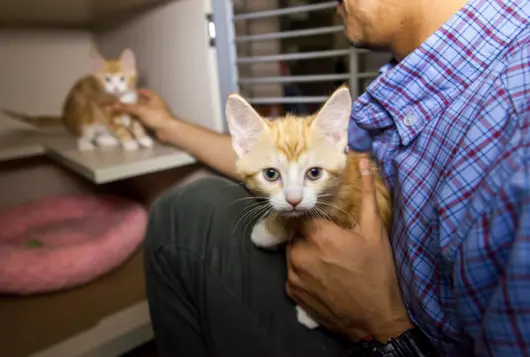Ringworm Management for Animal Shelters

Ringworm, also known as dermatophytosis, is a common zoonotic fungal disease that infects the skin, hair, and nails of mammals. Cats are the predominantly affected species in most shelters, though dogs, small mammals, and large animals can also develop ringworm infections. Ringworm is treatable and does not cause systemic disease, but it can be challenging to address in shelters due to its prolonged treatment course, hardiness in the environment, and potential for transmission to people.
Prevention
The most effective strategies to prevent the spread of ringworm in shelters and rescues are careful screening and monitoring, good husbandry, and operating within the organization’s capacity for care. There is currently no vaccine available to protect against ringworm infection.
All animals should be assessed for signs of ringworm at the time of intake. All cats, and dogs with suspicious clinical signs, should receive a Wood’s lamp examination [video] as part of their intake examination. A Wood’s lamp examination is a highly effective screening tool, but it will not detect all species of ringworm. Animals with suspicious clinical signs and a negative Wood’s lamp examination may still be infected with ringworm.
Clinical Signs
The most common sign of ringworm infection in cats and dogs is fur loss on the ears, muzzle, or paws, sometimes with scaling or crusting. However, ringworm can also cause dermatitis in a variety of different presentations and locations.
The following animals are more susceptive to developing clinical disease related to ringworm:
- Juveniles
- Animals experiencing chronic stress and overcrowding (e.g., from a hoarding situation)
- Certain breeds, including Persian cats and Yorkshire Terriers
Not all animals exposed to ringworm will develop clinical disease, particularly if none of the above risk factors are present.
Transmission
Ringworm is very hardy in the environment and can be readily spread via direct contact or fomites (objects or materials that are likely to carry infection, such as clothes, surfaces, furniture, etc.). Early detection of disease, isolation, and treatment of infected animals, and effective use of personal protective equipment (PPE) are important to control transmission from infected animals. Thorough mechanical cleaning is critical to decontaminate environments that have been exposed to significant levels of ringworm, followed by the application of an effective disinfectant.
Diagnosis
The most reliable diagnostic test for ringworm infection is a Dermatophyte Test Media (DTM) culture [video]. Animals with suggestive clinical signs and a positive Wood’s lamp examination can receive a presumptive diagnosis of ringworm and begin treatment. However, a DTM culture is still recommended to confirm the diagnosis and determine the ringworm species.
Other diagnostic tools include PCR testing and direct examination of hairs under the microscope (trichogram). These tests can be used as needed to confirm or rule out ringworm when the clinical signs and Wood’s lamp examination are equivocal.
Treatment & Management
Because ringworm is ultimately self-limiting, in certain scenarios where the zoonotic risk is low (e.g., community cats) it may be best not to treat and to allow the infection to resolve on its own. Treatment may also vary based on the species of ringworm diagnosed. However, for most cats diagnosed with ringworm in a shelter or foster setting, treatment is best achieved by administering an oral anti-fungal medication and performing twice weekly lime sulfur dips. Anti-fungal baths or mousse applications can be utilized instead of lime sulfur dips when needed for ease of application. Topical therapies are the most critical aspect of treatment in a population setting. Treatment is continued until resolution is confirmed via recheck DTM cultures. For more specific information on the treatment and management of ringworm, please see the University of Wisconsin Guidebook.
Foster and Adoption Considerations
Foster care is often the ideal setting for treating ringworm if foster caregivers are trained and provided with adequate supplies (for treatment, sanitation, and to prevent disease spread to themselves). Treatment in foster care mitigates the risk of in-shelter transmission, reduces the treatment burden on shelter staff and volunteers, and supports the emotional well-being of affected animals for the treatment duration.
Once animals have recovered after ringworm treatment, no additional precautions are generally necessary in the shelter or in the adoptive home. If an organization’s resources are limited, adoption of infected animals prior to disease resolution can be considered with disclosure of the treatment needs and zoonotic risk to the adopter.
Resources and Downloads
- University of Wisconsin Ringworm Guidebook
- Sample Ringworm SOP [PDF]
- Sample Foster Home Treatment Ringworm SOP [PDF]
- Ringworm: the Role of Staff and Volunteers in Fighting the Fungus [video - 2019 ASPCA Maddie’s Cornell Shelter Medicine Conference recording]
Last Reviewed October 2023
